Roofing Companies Gourock
Best Roofing Companies in Gourock
Receive multiple Roofers quotes for your project today! Compare profiles, reviews, accreditations, portfolio, etc... and choose the best deal.
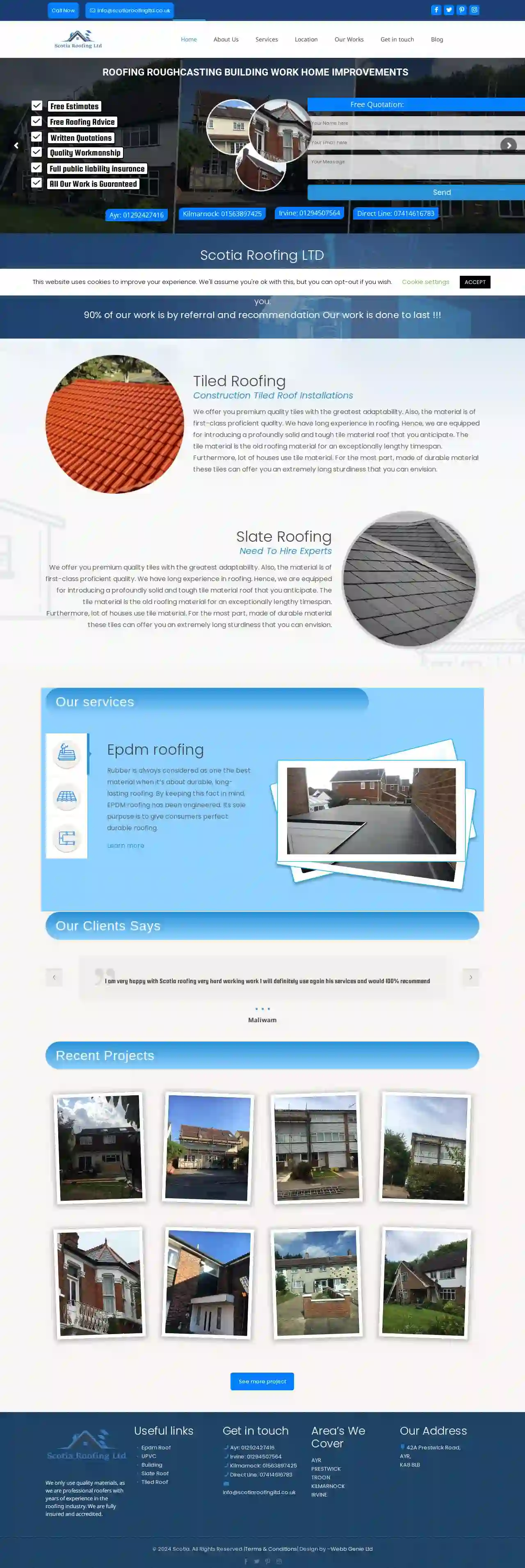
Scotia Roofing Ltd
51 reviews42A Prestwick Road, Ayr, KA8 8LB, GBScotia Roofing LTD is a roofing company based in Ayr, Scotland. They specialize in a variety of roofing services, including tiled roofing, slate roofing, EPDM roofing, and UPVC roofing. They also offer building works, exterior wall coating, sand stone restoration, and rough casting. Scotia Roofing LTD prides itself on using quality materials and having years of experience in the roofing industry. They are fully insured and accredited. The company serves a number of areas including Ayr, Prestwick, Troon, Kilmarnock and Irvine.
- Services
- Why Us?
- Accreditations
- Our Team
- Testimonials
- Gallery
Get Quote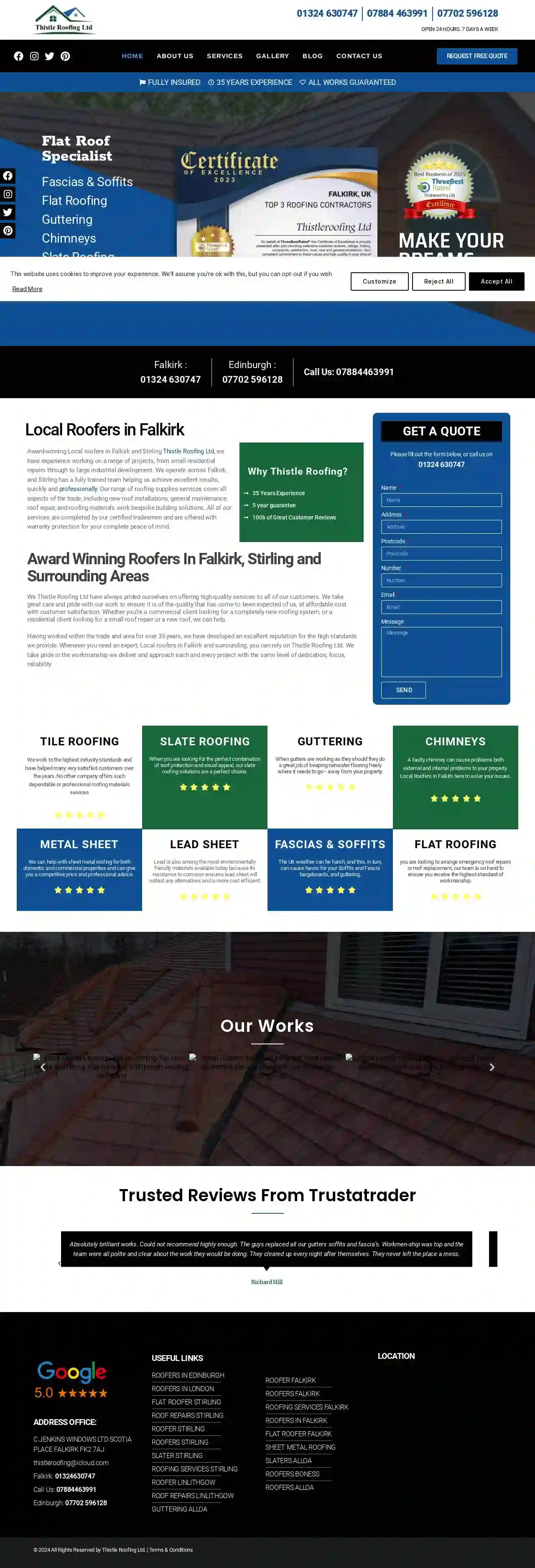
Thistle Roofing
4.446 reviewsC JENKINS WINDOWS LTD SCOTIA PLACE, FK2 7AJ, GBThistle Roofing Ltd is a family run business with over 35 years of experience in the roofing profession. We believe in offering our customers the best possible service for a very affordable price, and this is one of the guiding principles that are also important to our entire workforce. We take great care and pride with our work to ensure it is of the quality that has come to been expected of us, at affordable cost with customer satisfaction. Whether you’re a commercial client looking for a completely new roofing system, or a residential client looking for a small roof repair or a new roof, we can help.
- Services
- Why Us?
- Gallery
Get Quote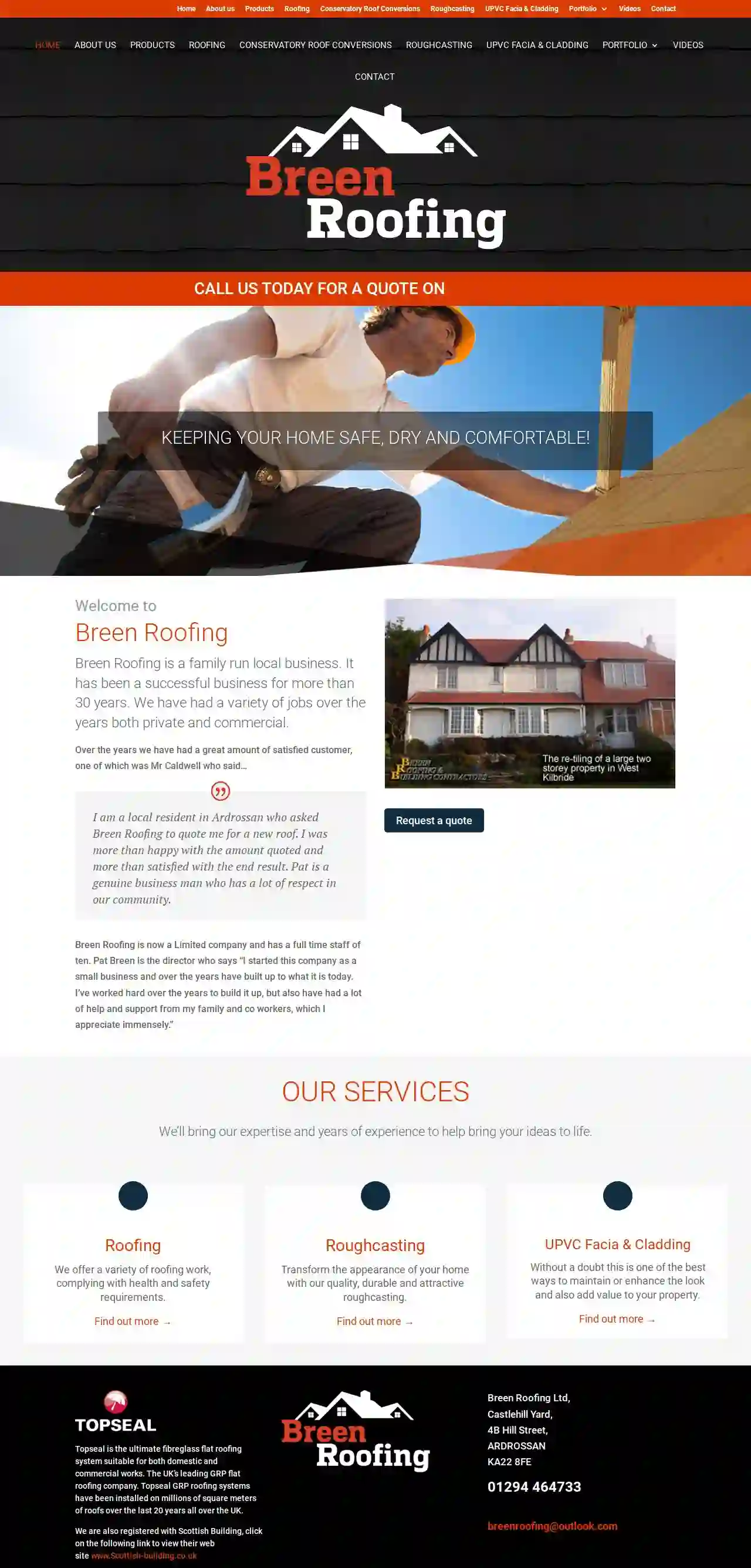
Breen Roofing
58 reviews4B Hill Street, Castlehill Yard, Ardrossan, KA22 8FE, GBBreen Roofing is a family-run local business with over 30 years of experience. We've successfully completed a variety of projects, both private and commercial. Our commitment to customer satisfaction is evident in the numerous positive testimonials we've received. One satisfied customer, Mr. Caldwell from Ardrossan, praised our competitive quotes and the high-quality workmanship. Breen Roofing has grown into a limited company with a dedicated team of ten employees. Pat Breen, the director, attributes the company's success to his hard work, the support of his family, and the dedication of his co-workers. We pride ourselves on providing a quality service, fast and reliable roofing solutions. Whether you need a new roof, roughcasting, UPVC facia and cladding, or a Topseal flat roofing system, our experienced team is here to help. Contact us today for a free quote and let us bring your roofing ideas to life.
- Services
- Why Us?
- Accreditations
- Our Team
- Testimonials
- Gallery
Get Quote
Norside Ltd
38 reviews21 St Mungo St, Bishopbriggs, G64 1QT, GBNorside is a roofing, general builders and multi trade company based in the Bishopbriggs area of Glasgow. Managing director Paul Smith started out as a sole trader, establishing Norside as a Limited company in 1996. Originally started as a roofing company, Norside has steadily progressed into general building and all trades, offering a varied service from roofing to refurbishments. We have a vast range of experience in all aspects of the construction industry. Norside deals with both private & commercial work. Renovations & extensions are carried out to the highest standard. We deal with all types of roofs and have over 30 years of experience. Over the last 25 years, Norside Ltd has moved into insurance works. Regular maintenance is important to properties, let us take care of it for you. Norside provides its own scaffold and scaffolders, who build and maintain the scaffold. Roof Maintenance Roofs are like cars and need maintained. Don't get caught out this winter. Call us now to book your annual roof maintenance check. 24hr Emergency Call Out Service – 07973634684 07812543545 07976321929 If you have a question, please contact at [email protected]
- Services
- Why Us?
- Our Team
- Gallery
Get Quote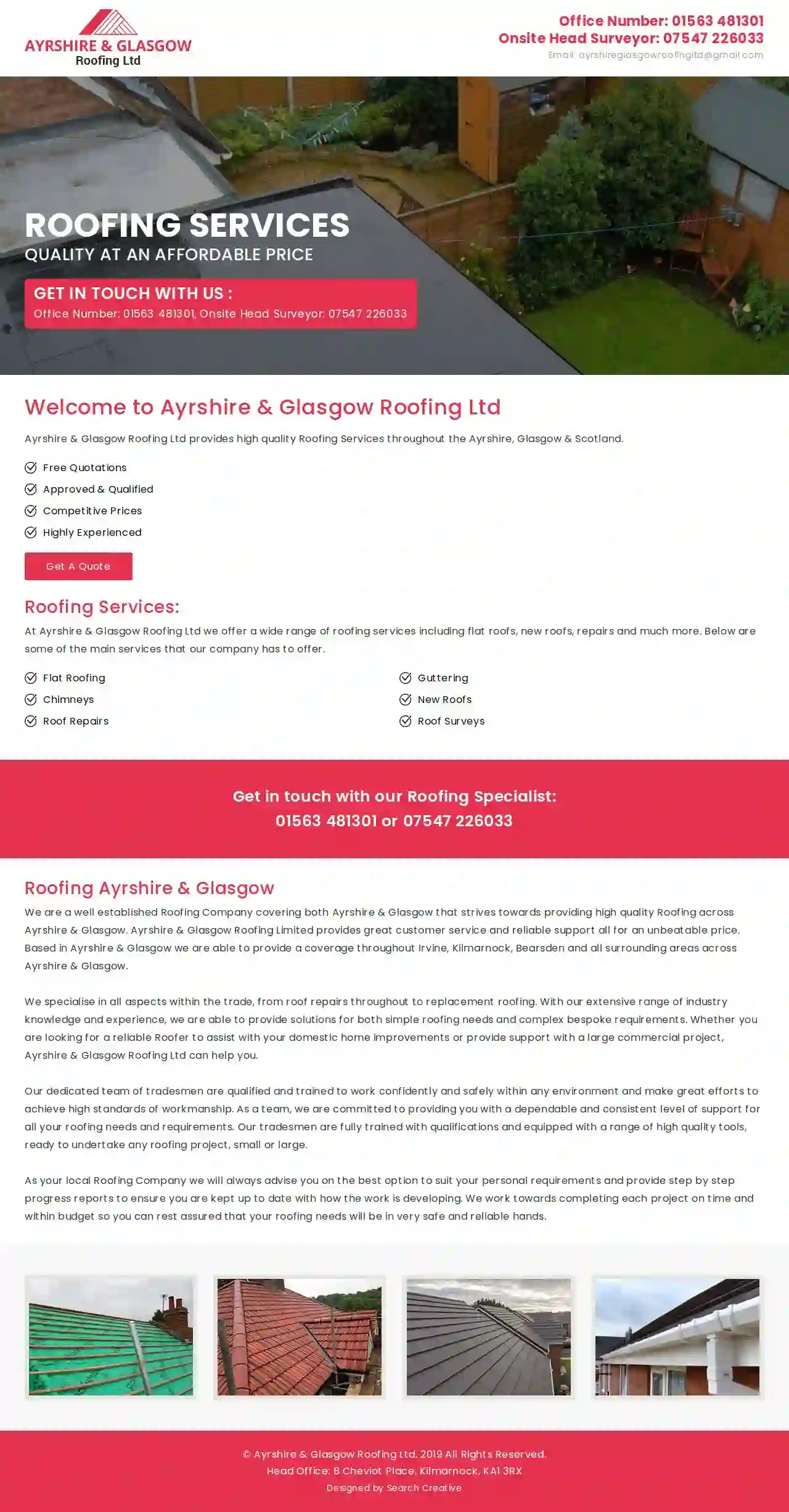
AYRSHIRE & GLASGOW ROOFING LTD
590 reviews8 Cheviot Place, Kilmarnock, KA1 3RX, GBAyrshire & Glasgow Roofing Ltd provides high quality Roofing Services throughout the Ayrshire, Glasgow & Scotland. We are a well established Roofing Company covering both Ayrshire & Glasgow that strives towards providing high quality Roofing across Ayrshire & Glasgow. Ayrshire & Glasgow Roofing Limited provides great customer service and reliable support all for an unbeatable price. Based in Ayrshire & Glasgow we are able to provide a coverage throughout Irvine, Kilmarnock, Bearsden and all surrounding areas across Ayrshire & Glasgow. We specialise in all aspects within the trade, from roof repairs throughout to replacement roofing. With our extensive range of industry knowledge and experience, we are able to provide solutions for both simple roofing needs and complex bespoke requirements. Whether you are looking for a reliable Roofer to assist with your domestic home improvements or provide support with a large commercial project, Ayrshire & Glasgow Roofing Ltd can help you. Our dedicated team of tradesmen are qualified and trained to work confidently and safely within any environment and make great efforts to achieve high standards of workmanship. As a team, we are committed to providing you with a dependable and consistent level of support for all your roofing needs and requirements. Our tradesmen are fully trained with qualifications and equipped with a range of high quality tools, ready to undertake any roofing project, small or large. As your local Roofing Company we will always advise you on the best option to suit your personal requirements and provide step by step progress reports to ensure you are kept up to date with how the work is developing. We work towards completing each project on time and within budget so you can rest assured that your roofing needs will be in very safe and reliable hands.
- Services
- Why Us?
- Gallery
Get Quote
JJP Roofing
52 reviews81 Fernhill Road, Rutherglen, G73 4HP, GB5 Star Roofing & Building Services Glasgow We help customers in Glasgow and surrounding areas to make the most out of their home. We are a family run business with over 28 years experience First class solutions for all roofing and general building work including Interior and Exterior Painting, Decorating, Rendering, Roughcasting, Patios, Driveways, all types of Brickwork, Landscaping, Fencing, and Decking. By choosing us you will be dealing with a reliable and trustworthy company and all work will be completed to the highest of professional standards. All work fully guaranteed No deposit required 14-Day cooling off period Interest-free payment plans Free estimates and advice Speak to a friendly member of our team today on 0141 2000 448 "Our conservatory roof had been leaking for years but after the heavy storms early this year we couldn't carry on doing small repairs. We got in touch with JJP and they came to give us a quote. We found them to be very professional and competent and this was reflected in their work. We use our conservatory as a dining area and it's now much more comfortable than before. The whole experience was hassle-free and and we can highly recommend this company to anyone." JM
- Services
- Why Us?
- Testimonials
- Gallery
Get Quote
A J Cladding Ltd
Glasgow Road, Unit 1, 100-102, Paisley, G73 1AA, GBAJ Cladding Ltd specialises in a range of Cladding material systems. We will provide the best solutions to our clients all over Scotland and all our staff are fully trained and are experienced installers.
- Services
- Why Us?
- Gallery
Get Quote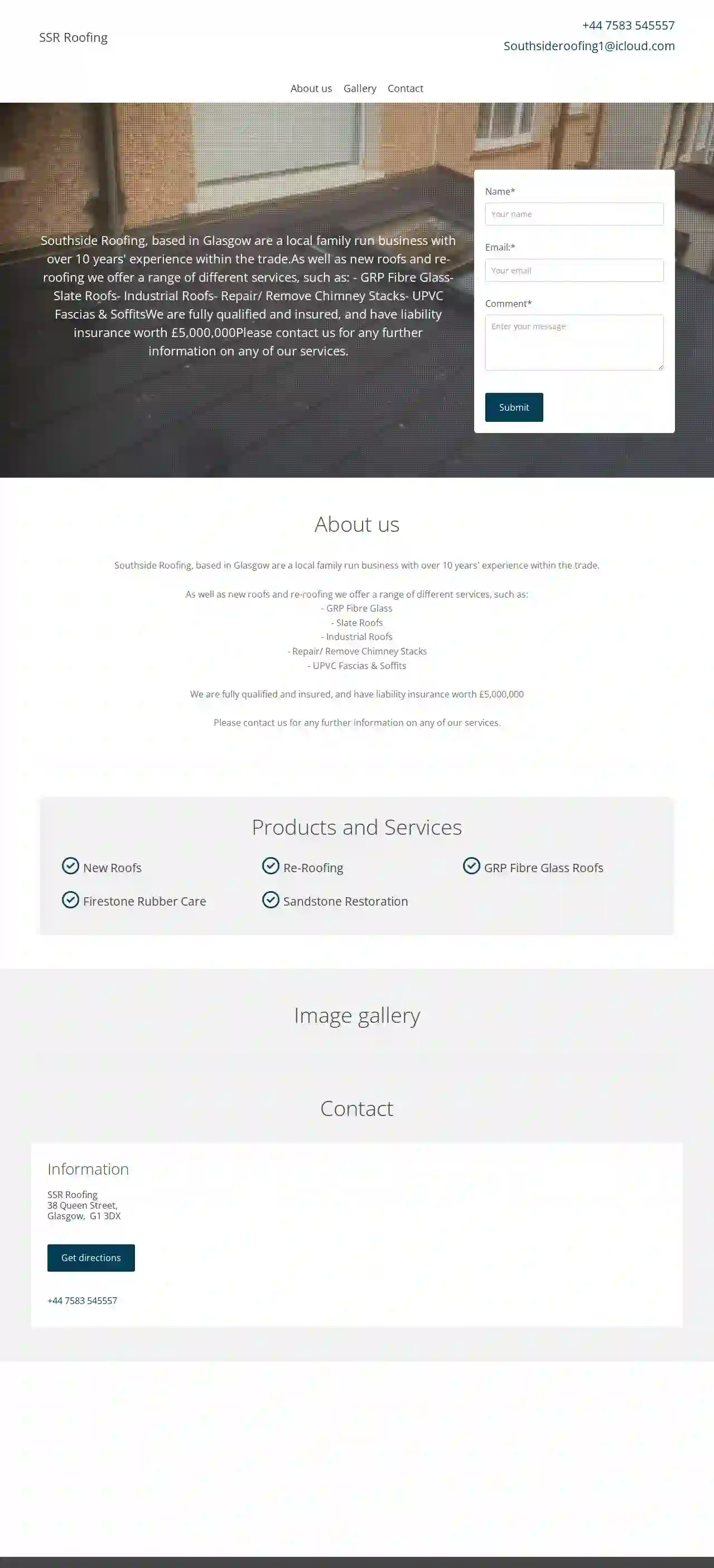
SSR Roofing
2.58 reviews38 Queen Street, Glasgow, G1 3DX, GBSouthside Roofing, based in Glasgow are a local family run business with over 10 years' experience within the trade. As well as new roofs and re-roofing we offer a range of different services, such as: - GRP Fibre Glass - Slate Roofs - Industrial Roofs - Repair/ Remove Chimney Stacks - UPVC Fascias & Soffits We are fully qualified and insured, and have liability insurance worth £5,000,000 Please contact us for any further information on any of our services.
- Services
- Why Us?
- Gallery
Get Quote
Burnside Roofing
53 reviews11 Craig Drive, Crosshouse, Kilmarnock, KA2 0JA, GBBurnside Roofing is a team of experienced and dedicated professionals who have been serving the Ayrshire community for over 10 years. We're entirely dedicated to providing high-quality roofing services that are tailored to meet the unique needs of each of our clients. Whether you need a simple repair or a complete roof replacement, we have the expertise and experience to do the job right the first time.
- Services
- Why Us?
- Accreditations
- Our Team
- Testimonials
- Gallery
Get Quote
McStay Roofing
4.47 reviews103 Clippens Road, Linwood, PA3 3PY, GBAt McStay Roofing, we are a family-run business with over 40 years of experience in the roofing industry. Through dedication and hard work, we have built an excellent reputation, attracting customers from across the Renfrewshire region. We stand behind the quality of our work, offering a complete guarantee on all projects. You can trust us to use only high-quality products, ensuring your roof lasts for years to come. Whether you need a repair or a full installation, our team is here to help. Contact us today for a free, no-obligation quote and experience the McStay Roofing difference.
- Services
- Why Us?
- Testimonials
- Gallery
Get Quote
Over 12,314+ Roofing Businesses onboarded
Our roofing experts operate in Gourock and surrounding areas!
Roofyng.co.uk has curated and vetted the Best Roofing Contractors in and around Gourock. Find a top & trustworthy contractor today.
Frequently Asked Questions About Roofing Companies
- Age: If your roof is nearing or exceeding its expected lifespan, it's wise to consider replacement.
- Multiple Leaks: Several leaks or leaks that reappear after repairs suggest a widespread problem.
- Extensive Damage: Large areas of damaged, missing, or deteriorated roofing materials might be too costly or difficult to repair effectively.
- Sagging or Structural Issues: Sagging, deflection, or other structural issues indicate a compromised roof that needs replacement.
- Granule Loss (Asphalt Shingles): Significant granule loss indicates weathering and reduced protection.
- Curling or Buckling Shingles: Signifies age or improper ventilation.
- Increased Energy Bills: A poorly insulated roof can lead to higher heating and cooling costs.
- Clear the Area: Remove any vehicles, outdoor furniture, or other items from around your house to provide the roofing crew with easy access.
- Protect Landscaping: Cover plants, shrubs, and other landscaping elements near the house with tarps or plastic sheeting to protect them from falling debris.
- Clear the Attic: Remove or cover items stored in your attic, as dust and debris might fall through during the removal of the old roof.
- Notify Neighbors: It's courteous to inform your neighbors about the upcoming roof replacement project, especially if it's likely to be noisy or disruptive.
- Discuss Logistics with the Contractor: Coordinate with the roofing contractor regarding access to your property, parking arrangements, and any special instructions or concerns you have.
What is the difference between a roof overlay and a roof tear-off?
Roof Overlay: Installing a new layer of roofing material over the existing roof. It's less expensive and faster, but not always ideal.
Roof Tear-Off: Completely removing the existing roofing before installing a new one. More labor-intensive but allows for inspection and repairs to the roof deck.
A tear-off is typically preferred, but a roofing contractor can advise on the best approach for your situation.
What are the signs that my roof needs to be replaced?
How do I prepare for a roof replacement?
What should I do with my old roof after replacement?
What is the difference between a roof overlay and a roof tear-off?
Roof Overlay: Installing a new layer of roofing material over the existing roof. It's less expensive and faster, but not always ideal.
Roof Tear-Off: Completely removing the existing roofing before installing a new one. More labor-intensive but allows for inspection and repairs to the roof deck.
A tear-off is typically preferred, but a roofing contractor can advise on the best approach for your situation.
What are the signs that my roof needs to be replaced?
- Age: If your roof is nearing or exceeding its expected lifespan, it's wise to consider replacement.
- Multiple Leaks: Several leaks or leaks that reappear after repairs suggest a widespread problem.
- Extensive Damage: Large areas of damaged, missing, or deteriorated roofing materials might be too costly or difficult to repair effectively.
- Sagging or Structural Issues: Sagging, deflection, or other structural issues indicate a compromised roof that needs replacement.
- Granule Loss (Asphalt Shingles): Significant granule loss indicates weathering and reduced protection.
- Curling or Buckling Shingles: Signifies age or improper ventilation.
- Increased Energy Bills: A poorly insulated roof can lead to higher heating and cooling costs.
How do I prepare for a roof replacement?
- Clear the Area: Remove any vehicles, outdoor furniture, or other items from around your house to provide the roofing crew with easy access.
- Protect Landscaping: Cover plants, shrubs, and other landscaping elements near the house with tarps or plastic sheeting to protect them from falling debris.
- Clear the Attic: Remove or cover items stored in your attic, as dust and debris might fall through during the removal of the old roof.
- Notify Neighbors: It's courteous to inform your neighbors about the upcoming roof replacement project, especially if it's likely to be noisy or disruptive.
- Discuss Logistics with the Contractor: Coordinate with the roofing contractor regarding access to your property, parking arrangements, and any special instructions or concerns you have.